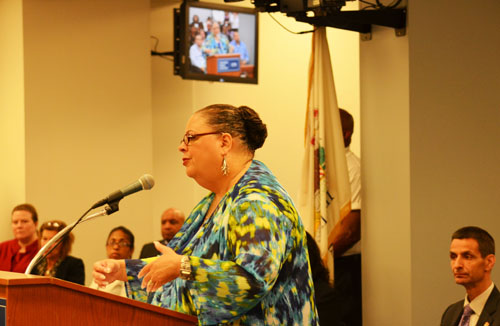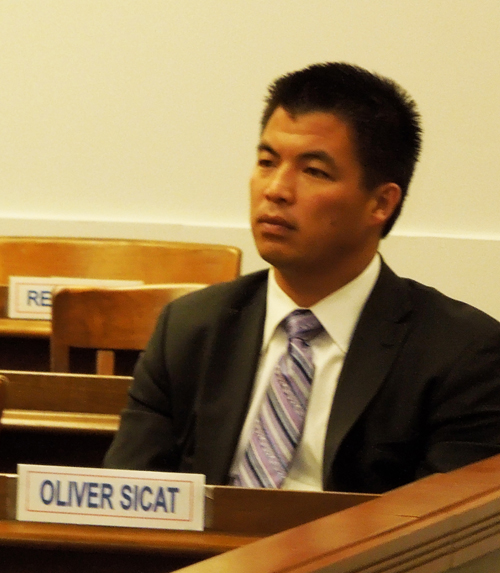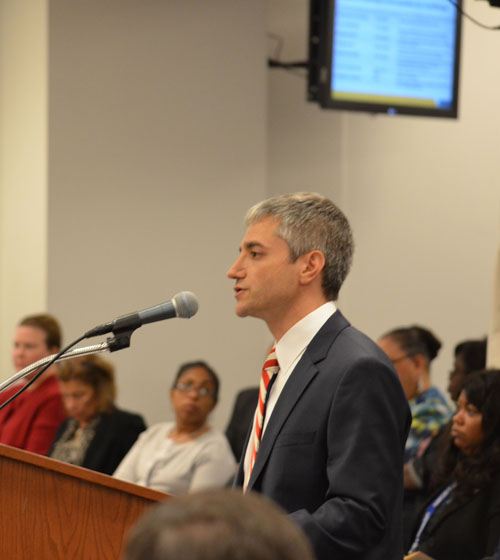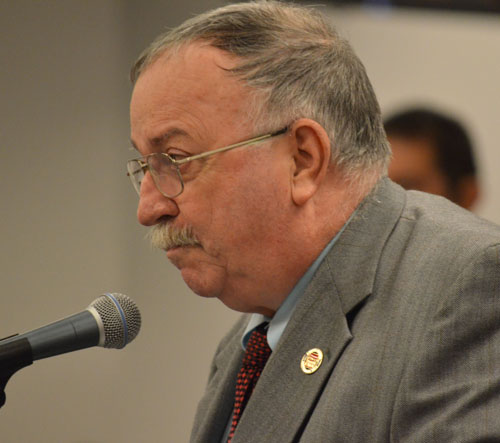BOARDWATCH: Facilities plan gets an 'F' a year after the 'Great Stalling' began... Power Point and 'plan' provide so few serious details that even the Board members express skepticism before voting for the 'plan'
Some teachers grade on a curve, and some grade ruthlessly on some absolute scale, but given all the massive amount of time and energy (and obfuscation) that went into the development of the CPS Facilities Plan, which was finally presented to the Board of Education at its September 25, 2013 meeting, by either measure the plan gets an "F". Having stalled the development of the plan (which was originally required by law for January 1, 2013) claiming they needed more time to do a really good job, the seven members of the Chicago Board of Education and the system's "Chief Executive Officer," Barbara Byrd Bennett, than turned the process into a pretext for closing 49 of the city's real public schools, while expanding, once again, the city's charter schools.
The school closings were voted on by the Board of Education, unanimously, at the Board's May 22, 2013 meeting. At that time, the Board members were claiming in public that the system faced a "billion dollar deficit." (That disappeared in July, but resumed its life as a constant talking point by the end of August).
 Standing before the Chicago Board of Education having read the complete Facilities Plan, Chicago Teachers Union President Karen Lewis (above) was like the teacher who didn't want to hurt the feelings of the student who was trying hard but didn't "get it." She listed the problems with the plan, urged the Board to do a lot of work on solving them, and then smiled and suggested that it was "incomplete." Substance photo by George N. Schmidt. Finally, on September 23, 2013, Chicago citizens who had access to a computer and excess storage space on their hard drives were able to get a copy of the long-awaited plan. And for those who had had the time to read it in the brief 48 hours before it came before the Chicago Board of Education for a vote, the document proved challenging in every way. It lacks an Index. It utilizes a bizarre version of the labeling of the city's communities, halfway between the traditional community labels and the even more bizarre designators that CPS decided to use when it changed its "Areas" to "Networks" following the inauguration of Mayor Rahm Emanuel in May 2011.
Standing before the Chicago Board of Education having read the complete Facilities Plan, Chicago Teachers Union President Karen Lewis (above) was like the teacher who didn't want to hurt the feelings of the student who was trying hard but didn't "get it." She listed the problems with the plan, urged the Board to do a lot of work on solving them, and then smiled and suggested that it was "incomplete." Substance photo by George N. Schmidt. Finally, on September 23, 2013, Chicago citizens who had access to a computer and excess storage space on their hard drives were able to get a copy of the long-awaited plan. And for those who had had the time to read it in the brief 48 hours before it came before the Chicago Board of Education for a vote, the document proved challenging in every way. It lacks an Index. It utilizes a bizarre version of the labeling of the city's communities, halfway between the traditional community labels and the even more bizarre designators that CPS decided to use when it changed its "Areas" to "Networks" following the inauguration of Mayor Rahm Emanuel in May 2011.
The plan may also have reflected the unseemly tumult within the leadership "team" that runs CPS. Virtually all of the original administrators charged with these matters had been purged by Emanuel's appointed Board of Education by October 2012. The administrators had been either forced to resign or disappeared (almost in the Central American sense). Gone by September 2013 were the "Chief Portfolio Officer" Oliver Sicat, who had been so central to the first year of the CPS facilities activities. Gone also was "Chief FACE Officer, Jamiko Rose," whose department of "Family and Community Engagement" had been turned over to a more reliable City Hall appointee, Phillip Hampton.  Oliver Sicat (above, during the February 22, 2012 meeting of the Chicago Board of Education) was the first (and only) "Chief Portfolio Officer" of the nation's third largest school system from the time he was hired by the Rahm Emanuel Board of Education in July 2011 until his disappearance in late 2012. Sicat, like a number of others, was gone from CPS shortly after the Board dumped Jean-Claude Brizard and made "Chief Executive Officer" of Chicago's schools out of Detroit administrator Barbara Byrd Bennett. Sicat's "Portfolio Office" disappeared with him. He was apparently replaced by "Chief Transformation Officer" Todd Babbitz, who is currently doing the "portfolio" work for the Board members, who love to use corporate jargon when discussing public schools and children. Sicat's qualifications for an executive job during Emanuel's first year atop Chicago's schools apparently were his gift for self-promotion and his experience as an administrator with the "Noble Network of Charter Schools." Substance photo by George N. Schmidt. Also gone, of course, was Emanuel's first "Chief Executive Officer," Jean-Claude Brizard. Brizard was gone by October 2012, after being publicly humiliated by Emanuel during the contract negotiations leading up to the Chicago Teachers Strike of 2012.
Oliver Sicat (above, during the February 22, 2012 meeting of the Chicago Board of Education) was the first (and only) "Chief Portfolio Officer" of the nation's third largest school system from the time he was hired by the Rahm Emanuel Board of Education in July 2011 until his disappearance in late 2012. Sicat, like a number of others, was gone from CPS shortly after the Board dumped Jean-Claude Brizard and made "Chief Executive Officer" of Chicago's schools out of Detroit administrator Barbara Byrd Bennett. Sicat's "Portfolio Office" disappeared with him. He was apparently replaced by "Chief Transformation Officer" Todd Babbitz, who is currently doing the "portfolio" work for the Board members, who love to use corporate jargon when discussing public schools and children. Sicat's qualifications for an executive job during Emanuel's first year atop Chicago's schools apparently were his gift for self-promotion and his experience as an administrator with the "Noble Network of Charter Schools." Substance photo by George N. Schmidt. Also gone, of course, was Emanuel's first "Chief Executive Officer," Jean-Claude Brizard. Brizard was gone by October 2012, after being publicly humiliated by Emanuel during the contract negotiations leading up to the Chicago Teachers Strike of 2012.
Not that there was a lot of public sympathy for Brizard when he disappeared. Brizard has been imported to Chicago from Rochester New York in May 2011 at the largest contract every paid to a Chicago Schools chief -- $250,000 annual salary; a "relocation allowance" of $30,000; and an unreported "performance bonus". Emanuel proclaimed that the guy from Rochester was the best person in the USA to run the nation's third largest school system, ignoring a controversial career in the much smaller New York city that had included an almost unanimous vote of "no confidence" from the city's teachers and many of the city's parents.
Almost predictably, Brizard lasted only 17 months before he was replaced by another out-of-town expert beholding to the mayor, former Detroit administrator Barbara Byrd Bennett. By September 2013, Byrd Bennett had seen the last of the top administrators imported by Brizard. In addition to the departure of Jamiko Rose and Oliver Sicat, Byrd Bennett had said good bye to "Chief Education Officer" Noemi Donoso (imported from Colorado), "Chief of Staff" Andrea Saenz, "Chief Instruction Officer" Jennifer Cheatham -- and a boatload of other lesser titled and lower paid individuals.
But just as the Board members never bothered to explain to the public their initial leadership choices, so by September 25, 2013 were they explaining how they came up with the latest version of the "team" although some with their business experience might just say that the entire thing was still in its "BETA" testing version, much like software which is never completely completed. The majority of the Board members are corporate approved.
The only thing Byrd Bennett's cabinet had on common with Brizard's cabinet was that most of them came from out of town and had been vetted not for their educational leadership talents but because the Broad Foundation liked them. Since Emanuel's inauguration, it is as if no one in Chicago -- and certainly not an educator with Chicago experience -- is qualified to be a CPS "Chief of Staff" or "Chief Officer for Innovation and Incubation", two titles currently in place). Of course, if Brizard needed a "Chief Portfolio Officer" (the once important Sicat), Byrd-Bennett didn't. Apparently in Sicat's place is the new "Chief Transformation Officer," a University of Chicago MBA named Todd Babbitz (hired in July 2012 at $165,000 per year.) No one on the Board asked why CPS no longer needed a "Chief Portfolio Officer" but suddenly needed a "Chief Transformation Officer"). At least publicly.
 Chicago Public Schools Chief Transformation Officer Todd Babbitz (above at podium) presented the Board with the Facilities Plan in a Power Point. During his narrative, he tried to claim that the document included the concerns of the thousands of citizens who had testified against the school closings between December 2012 and May 2013. As usual, the Board members (one of whom, Carlos Azcoitia, was absent) asked the presenter carefully scripted questions of the softball or even puffball kind. Substance photo by George N. Schmidt.But by September 25, 2013, when the Board met to vote on its facilities plan, it was the "Chief Transformation Officer" -- Todd Babbitz -- who presented the Power Point that presented the plan to the public and the Board members. Byrd Bennett was absent.
Chicago Public Schools Chief Transformation Officer Todd Babbitz (above at podium) presented the Board with the Facilities Plan in a Power Point. During his narrative, he tried to claim that the document included the concerns of the thousands of citizens who had testified against the school closings between December 2012 and May 2013. As usual, the Board members (one of whom, Carlos Azcoitia, was absent) asked the presenter carefully scripted questions of the softball or even puffball kind. Substance photo by George N. Schmidt.But by September 25, 2013, when the Board met to vote on its facilities plan, it was the "Chief Transformation Officer" -- Todd Babbitz -- who presented the Power Point that presented the plan to the public and the Board members. Byrd Bennett was absent.
Babbitz, whose qualifications to do the facilities report apparently begin and end with the fact that he had a graduate degree from the University of Chicago, didn't even realize that he had walked into a major example of Chicago racism during questions from the Board members. Trying to explain how Mayor Rahm Emanuel might have made the decision to provide an addition to the already privileged Walter Payton College Prep High School (which some call "Gold Coast High" because it was put where it is to facilitate residents of one of America's most expensive communities having a public private school), Babbitz noted that not all of the city's "College Prep Academic Magnet" high schools were overcrowded, as Payton has been according to the mayor.
Citing fact, Babbitz told the Board that three of Chicago's magnet high schools were, by CPS definitions, "underused" this school year. But, Babbitz said, residents of what he called the "Southwest Side" were demanding their own "College Prep Academic Magnet" high school, while refusing to attend Lindblom, King or Brooks high schools, which are already in operation.
Brooks, King and Lindblom have some of the city's best facilities, and all are scoring among the top high schools in the state despite some challenges. Babbitz left out the fact that Lindblom, King, and Brooks are (a) mostly black and (b) in black communities. What he may not have even known is that "Southwest Side" has long been Chicago code for "where the white people live" south of Roosevelt Road. (Lately, it's been expanded to include Latino people, but never -- ever -- black people). Another irony that may not have been apparent to the Board members -- or Babbitz -- is that Karen Lewis taught chemistry at King High School before she became President of the Chicago Teachers Union in July 2010.
So what the Board members and Babbitz deftly ignored, in the discussion of the "needs" of the "southwest side" was that many people in Chicago, even in 2013, consider any high school where the majority of the students are black (African American is challenging because many people in Chicago who are black come from Africa or the islands of the Caribbean) as not a place for their children to be.
 Although he could have provided the Board of Education with a history of the racist and class-biased planning that has characterized the Chicago public schools' facilities decisions for nearly 100 years (literally since the first Great Migration of Black People to Chicago during and after World War I), Substance editor and reporter George N. Schmidt (above speaking to the Board on September 25, 2013) chose to begin a lengthy critique of the Board's policies instead. He noted that since Rahm Emanuel created the current Board in May 2011, they have implemented the unprecedented policies of (a) not hiring executives from Chicago; (b) paying those from out of town enormous "relocations fees" when they are hired; and (c) not asking for the money back when those executives disappear from Chicago before their terms of office are ended. Schmidt provided the Board members with Board Reports showing how much they had voted to pay seven executives in "relocation and retention" expenses during their first 14 months in office, and he promised to return in December, after getting more information about the policies being implemented to discriminate against Chicago by Emanuel's Board, to provide a detailed history of the unprecedented spree of out-of-town hiring. A complete article on the presentation Schmidt prepared for the September 25, 2013 Board meeting is below. Substance photo by Marybeth Foley.Instead of creating a plan to require people who want an "academic magnet" high school education to go to one of the "academic magnet" high schools whose students are mostly black, Babbitz's facilities plan ignores the race issue completely. This is consistent with the current approach of CPS to racial questions. After 40 years of considering desegregation and keeping track of the racial demographics of Chicago, during Arne Duncan's time as "Chief Executive Officer," the Board of Education went to court to end federal monitoring of faculty and students desegregation. Duncan then ordered the Board's technical staff to stop publishing the annual "Racial Ethnic Survey of Staff."
Although he could have provided the Board of Education with a history of the racist and class-biased planning that has characterized the Chicago public schools' facilities decisions for nearly 100 years (literally since the first Great Migration of Black People to Chicago during and after World War I), Substance editor and reporter George N. Schmidt (above speaking to the Board on September 25, 2013) chose to begin a lengthy critique of the Board's policies instead. He noted that since Rahm Emanuel created the current Board in May 2011, they have implemented the unprecedented policies of (a) not hiring executives from Chicago; (b) paying those from out of town enormous "relocations fees" when they are hired; and (c) not asking for the money back when those executives disappear from Chicago before their terms of office are ended. Schmidt provided the Board members with Board Reports showing how much they had voted to pay seven executives in "relocation and retention" expenses during their first 14 months in office, and he promised to return in December, after getting more information about the policies being implemented to discriminate against Chicago by Emanuel's Board, to provide a detailed history of the unprecedented spree of out-of-town hiring. A complete article on the presentation Schmidt prepared for the September 25, 2013 Board meeting is below. Substance photo by Marybeth Foley.Instead of creating a plan to require people who want an "academic magnet" high school education to go to one of the "academic magnet" high schools whose students are mostly black, Babbitz's facilities plan ignores the race issue completely. This is consistent with the current approach of CPS to racial questions. After 40 years of considering desegregation and keeping track of the racial demographics of Chicago, during Arne Duncan's time as "Chief Executive Officer," the Board of Education went to court to end federal monitoring of faculty and students desegregation. Duncan then ordered the Board's technical staff to stop publishing the annual "Racial Ethnic Survey of Staff."
And so the discussion took on a bizarre turn, when two Board members asked questions that might have revealed the historic pattern of racism in CPS facilities planning, but instead sat like a lump of obnoxious material in the punch bowl of the Board's late but still here facilities party.
Despite the questions, the Board voted uninmously to approve the so-called plan, after each of the Board members went on the record stating that it really isn't a plan, actually. The euphemisms that were used by the various Board members will be evident when the video of the meeting appears on Cable TV on Saturday, September 28. What they all boil down to, however, has been evident since May 2011: the members of the Chicago Board of Education don't have an actual "plan" for anything, since Mayor Rahm Emanuel will finally decide what to do, either on impulse, or after careful consideration with some of the wealthiest and most powerful plutocratcs in Chicago.
If the mayoral frenzy of school facilities announcements during the week before the Board's September 25, 2013 meeting demonstrated nothing else, it was that Rahm runs the show. It wasn't even clear from what the six Board members said during their meeting whether the mayor had even told them about his expensive new facilities plans from Walter Payton to Wildwood, and from Gallistel to other places, before he began generating headlines every day as he rushed across the city announcing new schools and additions to old ones.
?


By: Rod Estvan
What capital plan if CPS blows up
I have very big reservations about the additional capital projects CPS is now discussing on carrying out with the support of TIF revenues from the city. I think TIF capital funding needs to be directed to things like basic maintenance, repair costs, some additional ADA access, air conditioning, and overcrowding relief at as many schools as possible instead of expansion projects for programmatic purposes. I agree with Substance that the expansion proposal for Payton is just stunning.
I have to give board member Henry Bienen credit for publicly stating that the ten year plan really does not make any commitments and it can hardly be called a plan. However the CPS credit situation is deteriorating rapidly and for good reason.
On Monday Fitch Ratings, Inc downgraded CPS yet again to a level of A-. This rating is still well within what are called "Investment grade� categories and indicates CPS debt currently poses a relatively low to moderate credit risk. But the problem is that two more steps down and CPS enters what is called a "Speculative grade" rating category. Fitch in its outlook states that the outlook for CPS is "Negative." Effectively Fitch is indicating CPS is heading towards a speculative grade rating.
They write: "Fitch will downgrade the rating into the 'BBB' category if there is not a clear and meaningful reversal in this trend (a structural budget gap) over the near term. Fitch believes the possibility of sufficient action to improve the rating or Outlook over that period is remote." The BBB rating is only one step above the speculative grade.
As some of you are aware in Access Living's last budget review of CPS we indicated we believed CPS was placing too much hope on so called pension reform allowing the district to free up many millions of dollars in order to right the fiscal situation. Really we are not talking about "reform," we are talking about plans for reducing retirement benefits.
Now we read: "Fitch discounts the probability of effective pension reform in time to meaningfully reduce the very large budget gap before reserves are all but depleted." CPS and the City of Chicago need to go to the General Assembly and seek permission to exceed the current property tax cap for at least three years. The district needs to generate revenue relatively rapidly and if a miracle occurs CPS can always lower the tax rate again. But right now there are no miracles on the horizon. (the Fitch report can be seen at http://www.fitchratings.com/creditdesk/press_releases/detail.cfm?pr_id=8...)
Rod Estvan